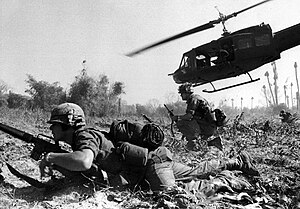| 1965 in the Vietnam War | |||
|---|---|---|---|
← 1964 1966 → | |||
 US Army soldiers disembarking from helicopters in the Ia Drang Valley | |||
| |||
| Belligerents | |||
|
Anti-Communist forces: |
Communist forces: | ||
| Strength | |||
|
US: 184,314 South Vietnam: 514,000 (including militia) | |||
| Casualties and losses | |||
|
US: 1,928 killed[1] South Vietnam: 11,242 killed.[2]: 275 | U.S estimate: 35,436 killed[citation needed] | ||

In 1965, the United States rapidly increased its military forces in South Vietnam, prompted by the realization that the South Vietnamese government was losing the Vietnam War as the communist-dominated Viet Cong (VC) gained influence over much of the population in rural areas of the country. North Vietnam also rapidly increased its infiltration of men and supplies to combat South Vietnam and the U.S. The objective of the U.S. and South Vietnam was to prevent a communist take-over. North Vietnam and the VC sought to unite the two sections of the country.
Political instability and internal dissent continued to plague the government of South Vietnam, although in June General Nguyễn Văn Thiệu and Air Marshall Nguyễn Cao Kỳ took control of the country and remained in power for the remainder of the year. In the United States, a majority of Congress and the people supported U.S. participation in the war, although protests against the war became larger and more frequent, especially among college students.
The U.S. began bombing North Vietnam in March, in Operation Rolling Thunder. The U.S. Army and Marines began ground operations to ferret out and defeat the communist forces. U.S. Military Assistance Command Vietnam (MACV), commanded by General William Westmoreland adopted a strategy of attrition, employing U.S. superiority in firepower, technology, and mobility. The usual military tactic of the United States was search and destroy operations in which large U.S. and South Vietnamese units, supported by air and artillery, swept through an area to attempt to engage the communists in battle. The People's Army of Vietnam (PAVN) and the VC, by contrast, relied on hit-and-run operations and ambushes, avoiding set-piece battles except at their own initiative.
In November, the U.S. and PAVN met head-on for the first time in the Battle of Ia Drang. Both sides claimed victory. The U.S. inflicted heavy casualties on the PAVN, but the battle vindicated the conviction by North Vietnam that its military could slowly grind down the U.S.'s commitment to the war.
South Korea contributed an army division to South Vietnam, while Australia, New Zealand and other countries provided smaller numbers of soldiers. North Vietnam received military aid from the Soviet Union and China.
At year's end, President Lyndon Johnson declared a temporary halt to the bombing of North Vietnam and undertook a diplomatic initiative to seek negotiations with North Vietnam. North Vietnam, on its part, aimed to achieve a decisive military victory, but prepared also for an expanded war if the U.S. continued to escalate its involvement.
- ^ "Vietnam War U.S. Military Fatal Casualty Statistics". National Archives. 15 August 2016. Retrieved 10 October 2021.
- ^ Clarke, Jeffrey (1988). United States Army in Vietnam: Advice and Support: The Final Years, 1965-1973. Center of Military History, United States Army. ISBN 978-1518612619.
 This article incorporates text from this source, which is in the public domain.
This article incorporates text from this source, which is in the public domain.